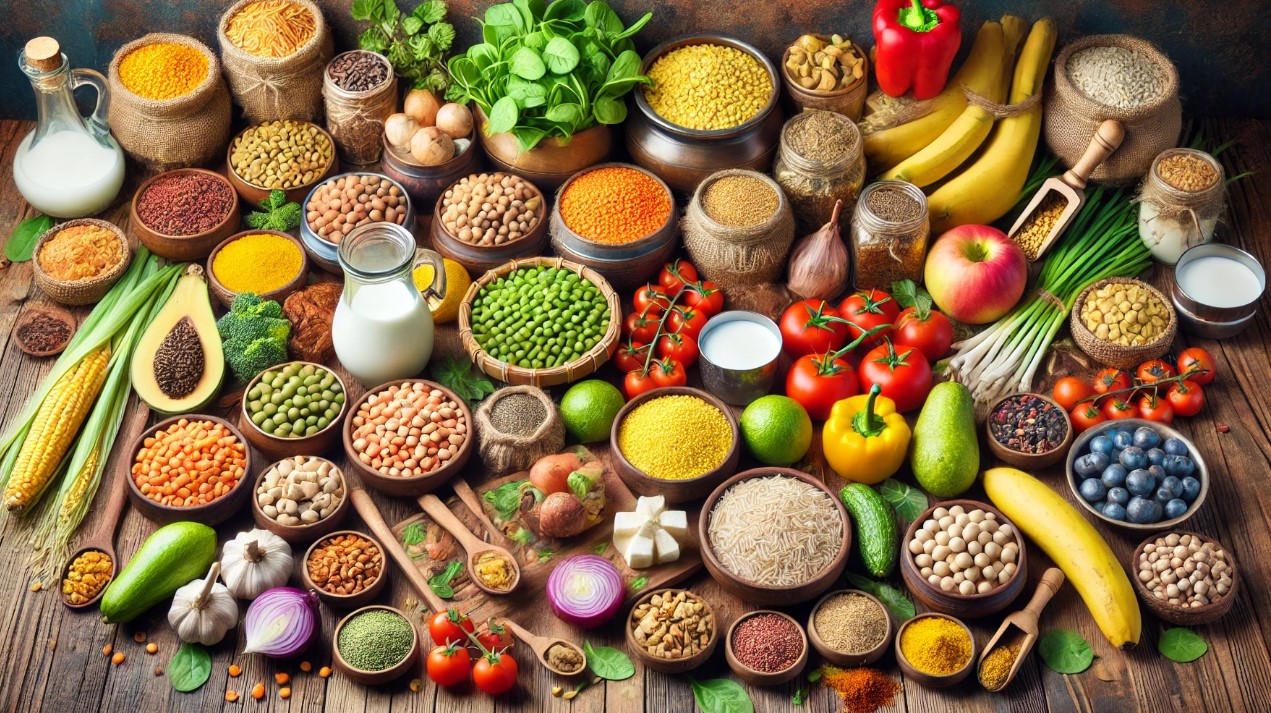Here’s a list of Indian superfoods that are not only affordable but are also staples in most Indian households. These foods are nutrient-rich, versatile, and rooted in traditional Indian diets:
1. Pulses and Legumes
- Lentils (Dal):
- Common varieties: Toor dal, Moong dal, Masoor dal, Chana dal.
- Benefits: Rich in protein, fiber, and essential minerals.
- Uses: Dal curries, soups, khichdi.
- Chickpeas (Chana):
- Includes: Kabuli chana (white) and Kala chana (black).
- Benefits: High in protein, fiber, and iron.
- Uses: Curries, snacks, sprouts.
- Green Gram (Moong):
- Benefits: Protein-rich, good for digestion, easily digestible.
- Uses: Sprouts, khichdi, dosa batter.
2. Whole Grains
- Rice:
- Types: White rice, brown rice, red rice.
- Benefits: Source of energy, easily digestible.
- Uses: Pulao, khichdi, idli, dosa.
- Whole Wheat:
- Benefits: High in fiber, good for digestion.
- Uses: Rotis, parathas, bread.
- Flattened Rice (Poha):
- Benefits: Light, easy to digest, rich in iron.
- Uses: Breakfast dishes, snacks.
3. Vegetables
- Onion:
- Benefits: Antioxidant-rich, boosts immunity, heart-healthy.
- Uses: Base for curries, raw in salads, chutneys.
- Garlic:
- Benefits: Reduces cholesterol, boosts immunity.
- Uses: Curries, stir-fries, chutneys.
- Potatoes:
- Benefits: Rich in potassium and carbs for energy.
- Uses: Curries, snacks, stews.
- Tomatoes:
- Benefits: Rich in vitamin C, antioxidants like lycopene.
- Uses: Curries, soups, salads.
- Spinach (Palak):
- Benefits: High in iron, calcium, and vitamin K.
- Uses: Palak paneer, soups, smoothies.
- Coriander (Dhania):
- Benefits: Rich in vitamins A, C, and K, aids digestion.
- Uses: Garnish, chutneys, flavoring.
4. Fruits
- Bananas:
- Benefits: Rich in potassium, quick energy source.
- Uses: Raw, smoothies, desserts.
- Lemon:
- Benefits: High in vitamin C, aids digestion.
- Uses: Lemon water, salads, curries.
- Mango (Seasonal):
- Benefits: High in vitamin A and antioxidants.
- Uses: Raw as pickles, ripe as desserts or juice.
5. Spices
- Turmeric (Haldi):
- Benefits: Anti-inflammatory, boosts immunity.
- Uses: Curries, golden milk, teas.
- Cumin (Jeera):
- Benefits: Aids digestion, detoxifying properties.
- Uses: Tadka for curries, water infusion.
- Fenugreek Seeds (Methi):
- Benefits: Controls blood sugar, aids digestion.
- Uses: Curries, soaked in water, pickles.
- Mustard Seeds (Rai):
- Benefits: Supports metabolism, rich in selenium.
- Uses: Tadka, pickles, curries.
- Cinnamon (Dalchini):
- Benefits: Regulates blood sugar, rich in antioxidants.
- Uses: Tea, curries, desserts.
6. Dairy
- Milk:
- Benefits: Rich in calcium, protein, and vitamin D.
- Uses: Beverages, curd, desserts.
- Curd (Dahi):
- Benefits: Probiotic, supports gut health.
- Uses: Raita, smoothies, buttermilk.
- Paneer (Cottage Cheese):
- Benefits: High in protein and calcium.
- Uses: Curries, snacks, salads.
7. Oils and Fats
- Ghee (Clarified Butter):
- Benefits: Rich in healthy fats, supports digestion.
- Uses: Cooking, spreading on rotis, desserts.
- Coconut:
- Benefits: Rich in healthy fats, boosts energy.
- Uses: Grated, coconut water, oil.
8. Seeds and Nuts
- Peanuts:
- Benefits: High in protein, good fats, and energy.
- Uses: Roasted, chutneys, snacks.
- Sesame Seeds (Til):
- Benefits: Rich in calcium and magnesium.
- Uses: Chutneys, laddoos, toppings.
- Flaxseeds (Alsi):
- Benefits: High in omega-3, good for heart health.
- Uses: Sprinkle on rotis, smoothies.
9. Sweeteners
- Jaggery (Gur):
- Benefits: Rich in iron and minerals, a natural sweetener.
- Uses: Sweets, chai, snacks.
- Honey:
- Benefits: Natural sweetener, boosts immunity.
- Uses: Tea, desserts, as a spread.
10. Herbal Teas and Infusions
- Tulsi (Holy Basil):
- Benefits: Boosts immunity, reduces stress.
- Uses: Herbal tea, infused water.
- Ginger:
- Benefits: Aids digestion, reduces inflammation.
- Uses: Ginger tea, curries.
- Cardamom (Elaichi):
- Benefits: Improves digestion, detoxifying properties.
- Uses: Tea, desserts, curries.
Why These Foods Are Affordable
- Most of these superfoods are staples in Indian households and are widely grown across India.
- Their affordability comes from minimal processing and their integration into everyday diets.
